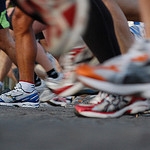Cadence Manipulation Effects on Impact Injuries
Posted by Rich Souza PT, PhD on October 1, 2012

The Starting Line:
Can cadence manipulation help prevent running injuries?
When runners run with long slow strides, they tend to land on straight stiff knees. This pattern results in large impact forces that propagate up the leg. Such large impacts during a repetitive activity like running add up, and may lead to injuries such as stress fractures and joint problems in some runners.
Cadence manipulation - intentionally changing the number of steps in a minute during running - is an indirect strategy to shorten stride length. By increasing the number of steps per minute, the runner intuitively reduces the stride length. A great article by Heiderscheit et al. in a paper in 2011 showed desired joint loading reductions at the knee and hip when runners increased their cadence by 10%. Another benefit is to minimize the vertical displacement of the runner’s center of mass upwards and downwards, which promotes a more efficient running style. Less energy spent going up and down means more energy spent going forward. A shorter stride length and less braking impulse was also seen in the research subjects after increasing cadence by 10%.
A good way to experiment with cadence is to run on a treadmill at a fixed speed and count the number of strides per minute. Then, keeping the speed constant, try to vary the number of strides per minute. Increasing the cadence at a fixed speed should result in less overstriding and lower impact forces in runners with low cadence.
Not everyone needs to worry about cadence. Elite runners seem to average approximately 180 strides per minute. For healthy runners without history of these types of impact injuries (stress fractures, joint problems, etc), there is currently no evidence that adopting a high cadence will prevent new injuries from occurring. However, for runners already struggling with injuries, who tend to over-stride with slow long strides, cadence manipulation can be a very effective tool at reducing the impact forces in the lower extremities.
The Finish Line:
An increase in cadence by even 10% can reduce forces at the knee and hip and lead to a shorter stride, which is particularly helpful In runners with injuries resulting from overstriding.
References:
1. Heiderscheit BC, Chumanov ES, Michalski MP, Wille CM, Ryan MB. Effects of step rate manipulation on joint mechanics during running. Med Sci Sports Exerc. 2011 Feb;43(2):296-302. http://www.ncbi.nlm.nih.gov/pubmed/20581720
Photo Credit: Josiah Mackenzie via photopin cc
*Note: This general information is not intended to be a substitute for medical treatment or advice. Always consult a professional before making changes to your health and wellness practices.
Feedback or suggestions for future topics? Let us know!

